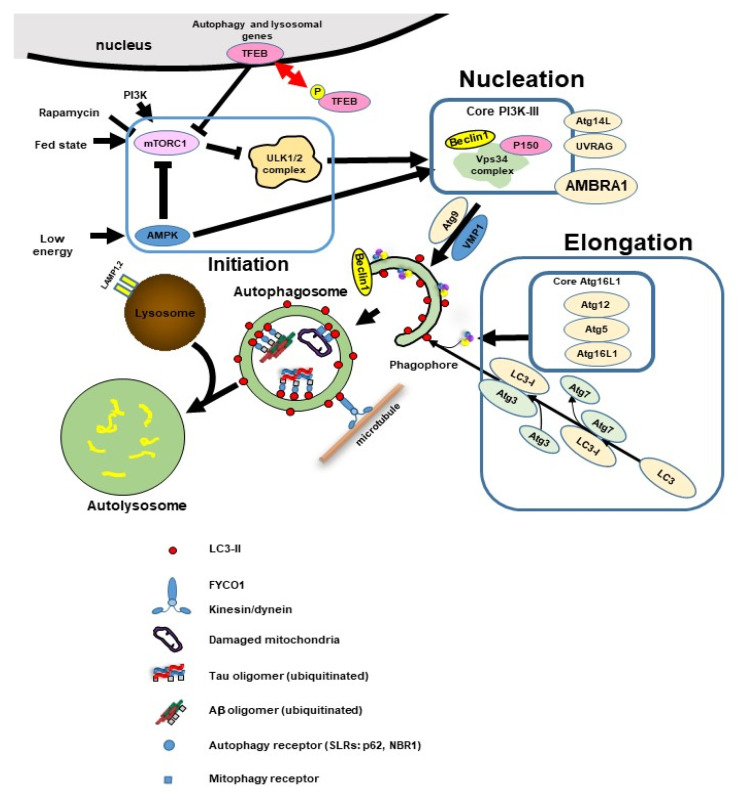Figure 4.
The sequence of autophagy in mammals. a. Initiation. In response to nutrient deprivation, AMPK phosphorylates mTORC1, releasing its inhibition on ULK, and activates the initiation complex. Downregulation of mTORC1 leads to the translocation of TFEB to the nucleus, where TFEB becomes upregulated, and various autophagy- and lysosome-related gene translation is done. ULK phosphorylates AMBRA-1, which promotes the interaction of Beclin-1 with p150 and PI3K-III (Vps34) in the PI3K-III complexes. UVRAG and Atg14L bind differently to form separate PI3K-III-complex populations in cells. AMBRA-1 also interacts with PI3K-III- complexes. B. Nucleation. ULK- and PI3K-III-complexes are translocated to early phagophore sites later with the help of Atg9 and VMP1, and local production of PI3P causes the recruitment of additional effectors and the first segregating membrane is formed. C. Elongation. Immediately after the activation of autophagy, Atg7 is upregulated, promoting Atg5-Atg12 dimer formation, which connects to Atg16L1 to form the Atg16L1 elongation complex. Atg7 also oversees the cleavage and lipidation of LC3 to LC3-I and then to LC3-II, which binds to the inside and outside of the formed phagosomal membrane. Mitochondria can be directly bound by mitochondrial receptors without poly-ubiquitination. In aggrephagy, poly-ubiquitinated protein aggregates (Aβ oligomer and tau oligomer) are engulfed by the phagophore via SLRs (sequestosome 1/p62-like receptors), which include P62 or NBR1. D. Maturation. Once the loaded phagophore is closed and the outer fraction of LC3-II is removed, the completed autophagosome fuses with the lysosome via a bonding process involving syntaxin members, and LAMP-1 and -2 creating an autolysosome. Autophagosomes are produced in the cytoplasm at random sites. The autophagosomes are delivered to lysosomes at the microtubule-organizing center. Transport of autophagosomes toward the plus end of microtubules involves the interaction of the LIR motif of FYCO1 with LC3-II on the outer membrane of the autophagosome. Abbreviations: PI3K-III: class III phosphatidylinositol 3-kinase; LC3-II: microtubule-associated protein light chain 3-II; LAMP-1, LAMP-2:lysosome-associated membrane protein 1, 2; SLRs: Sequestosome 1/p62-like receptors; FYCO1: FYVE and coiled-coil domain containing 1; p62: p62/sequestosome-1; NBR1: neighbor of BRCA1 gene 1; TFEB: transcription factor EB.

